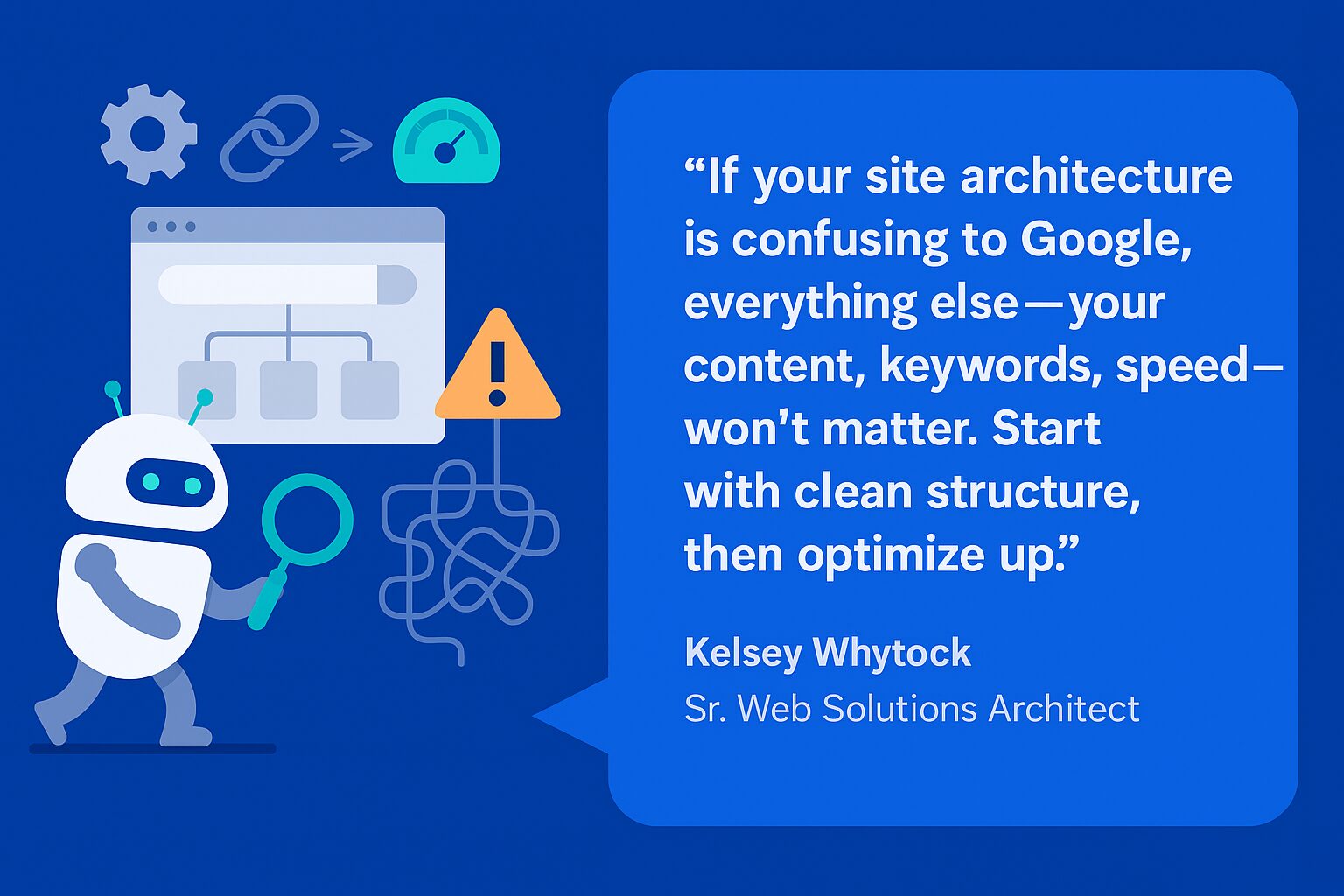-
Use Keyword-Focused, Clear Titles and Meta Descriptions: Craft H1 titles with primary keywords upfront, keep them under 60 characters, and write meta descriptions that clearly state what your page offers, enticing users to click.
-
Structure Content with Headings and Clean URLs: Break up text with logical H2s and H3s that include relevant keywords. Create short, descriptive, hyphenated URLs that reflect the page’s topic.
-
Optimize Images for Speed, SEO, and Accessibility: Compress images before uploading, use keyword-rich filenames, and add descriptive alt text, improving load times, rankings, and accessibility.
-
Link Internally to Support SEO and User Flow: Add links to related services, blogs, or case studies to distribute SEO value, keep visitors engaged, and guide them to conversions.
-
Write for Humans First, Then Fine-Tune for Search: Prioritize clear, relevant content that answers your audience’s real questions. Avoid keyword stuffing; readability and usefulness boost both engagement and rankings.
Most marketing managers in B2B manufacturing wear a lot of hats: strategy, execution, content, campaigns, analytics. And somewhere in the middle of it all, you’re expected to “handle SEO.”
You know your website needs to rank. You know search visibility drives lead generation. But carving out time to become an SEO expert? Not in the cards.
The good news: you don’t need to master every algorithm update to improve your site’s visibility. With a solid understanding of on-page SEO, you can make high-impact updates quickly and show measurable results.
This guide is built specifically for mid-level marketers like you. Let’s dive in.
What Is On-Page SEO and Why It Matters
On-page SEO refers to the elements you control directly on your website that help search engines understand your content and rank it appropriately.
That includes things like:
- Headlines and metadata
- URL structure
- Internal linking
- Image optimization
- Page structure and readability
In manufacturing, where buyers are technical and research-driven, showing up for the right search terms is critical. Strong on-page SEO ensures your valuable content actually gets found.

The On-Page SEO Essentials (You Can Tackle Today)
You don’t need to overhaul your site to see improvements. Focus on these key areas for immediate wins.
1. Use Keyword-Focused, Clear Page Titles (H1 Tags)
Your primary page title, usually in the H1 tag, tells both users and search engines what your page is about.
Quick checklist:
- Include your target keyword near the beginning
- Keep it under 60 characters
- Make it clear and benefit-driven (avoid vague, internal jargon)
Example:
Instead of “Solutions for Success,” try “Custom CNC Machining Services for Aerospace Manufacturing”
2. Optimize Meta Descriptions for Click-Throughs
Meta descriptions don’t directly affect rankings, but they do influence clicks. They’re your page’s sales pitch on Google.
Best practices:
- 150–160 characters
- Include the primary keyword
- Clearly state what the page offers or solves
3. Structure Content with Headings (H2s, H3s)
Search engines scan subheadings to understand the flow and topics of your content. Readers do too.
Tips:
- Use one H1 per page, followed by logical H2s and H3s
- Break up content every 2–3 paragraphs
- Include keywords in at least one or two subheadings
4. Make URLs Clean and Descriptive
Avoid URLs like:
www.example.com/page123?id=57&ref=xyz
Instead, use:
www.example.com/industrial-pump-repair
Guidelines:
- Keep URLs short, lowercase, and hyphenated
- Include your target keyword
- Avoid dates unless they’re essential
5. Add Internal Links Thoughtfully
Linking to other pages on your site helps distribute SEO value and keeps visitors engaged.
Try linking to:
- Related services or blog posts
- Case studies that support the page’s content
- Product pages tied to the topic
Bonus: This also supports better site navigation and conversion rate optimization.
6. Optimize Images for Speed and SEO
Large or unoptimized images slow your site down and slow sites don’t rank well.
Checklist:
- Compress images before uploading
- Use descriptive filenames (e.g., hydraulic-valve-installation.jpg)
- Add alt text that describes the image and includes keywords naturally
- Ensure images meet accessibility standards
7. Write for Users First, Then Fine-Tune for Search
Google prioritizes helpful, relevant content. So avoid keyword stuffing and focus on answering your audience’s real questions.
Ask yourself:
- Does this page clearly explain the topic?
- Is it tailored to someone in manufacturing, not general business?
- Would I stay on the page or hit the back button?
If it reads like it was written for a person, not a robot, you’re on the right track.
Advanced Bonus: Schema Markup (Optional)
If you have some dev support, adding schema markup (structured data) helps search engines better interpret your content and can unlock rich results like FAQs or ratings.
Not required, but worth exploring down the line with or development help.
What On-Page SEO Success Looks Like
You’re not aiming to become an SEO wizard overnight. But with consistent on-page updates, here’s what you can expect:
- Higher visibility for key pages in organic search
- More qualified visitors arriving from relevant terms
- Increased engagement (time on page, lower bounce rate)
- Clearer conversion paths and form fills
- Better synergy between paid and organic campaigns
- Stronger support for lead generation
How 3 Media Web Can Help
At 3 Media Web, we help manufacturing marketers bring clarity, performance, and results to their SEO strategy, without overcomplicating it.
Our on-page SEO services include:
- Full-page audits with actionable recommendations
- Keyword strategy aligned to buyer intent
- Content editing and metadata updates
- Image optimization and page speed improvements
- Ongoing collaboration with your team or web design and development partner
Whether you want a quick win or a long-term roadmap, we’ll help you turn your website into a search-friendly, results-driven asset.
